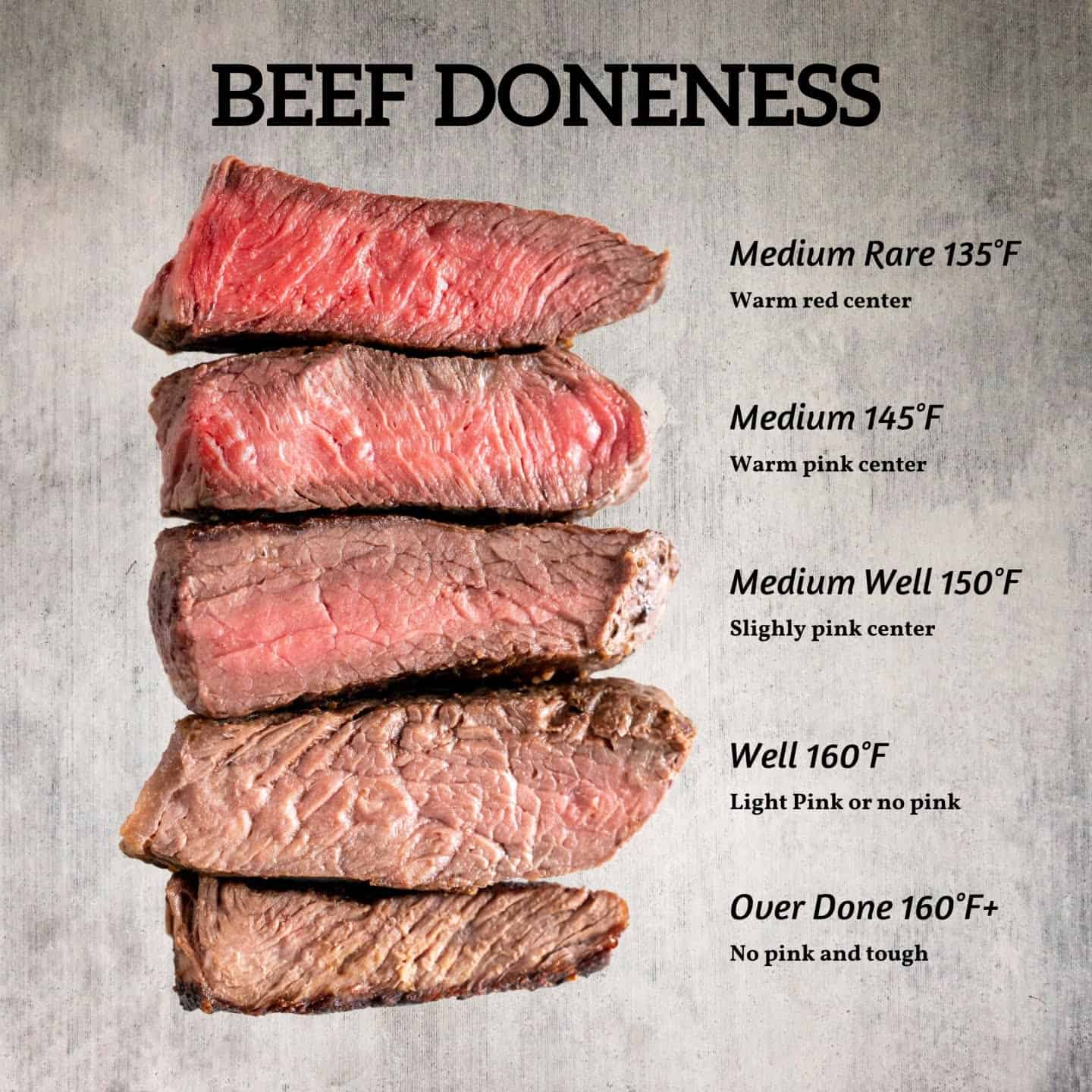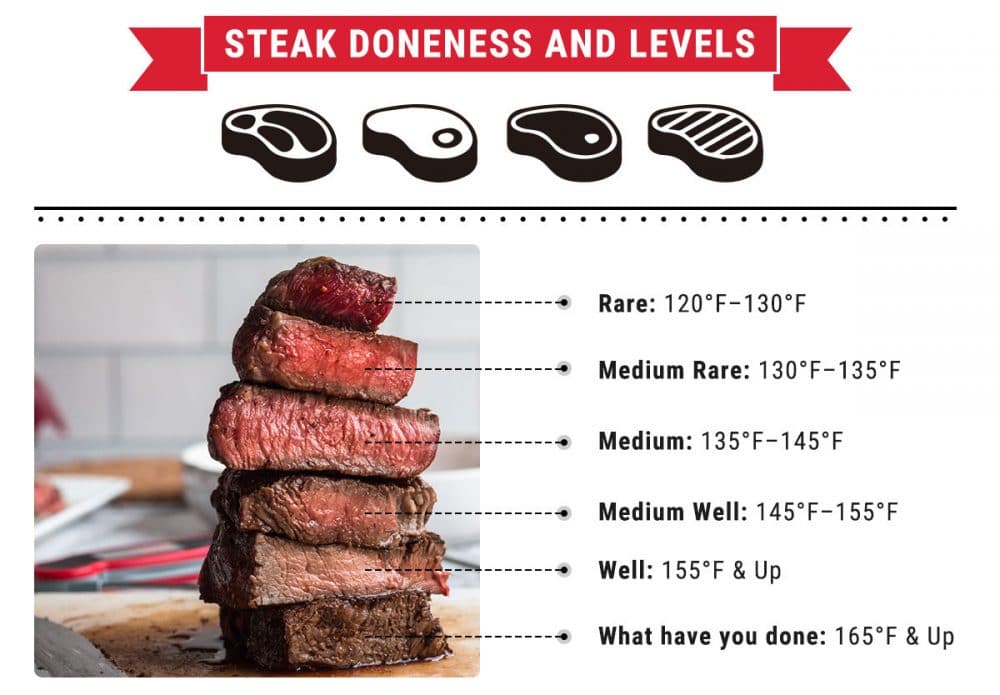Steak Doneness Guide: Cook Steak Perfectly Every Time!
Ever wondered how to achieve that perfect steakhouse sear and a juicy, flavorful center, every single time? Mastering the art of cooking steak to your desired doneness is not a matter of guesswork, but a science achievable with the simple use of a meat thermometer.
The quest for the perfectly cooked steak is a culinary pursuit shared by home cooks and seasoned chefs alike. The secret, however, lies not in years of experience alone, but in the precise control offered by a meat thermometer. Forget relying on touch or vague estimations; a thermometer empowers you to consistently replicate your ideal level of doneness, ensuring a tender, flavorful, and safe dining experience. We will show you all of it.
| Topic | Details |
|---|---|
| Key Concept | The use of a meat thermometer to achieve precise control over steak doneness. |
| Temperature's Role | Internal temperature dictates the level of doneness, impacting texture, flavor, and safety. |
| USDA Guidelines | While standard, these guidelines are often surpassed by chefs seeking juicier results. |
| Medium Rare Ideal | Achieved between 130F and 135F, allowing fat to render for maximum flavor. |
| Resting the Steak | Crucial for retaining moisture; recommended rest time is at least 30 minutes. |
| Thermometer Placement | Insert from the side into the thickest part for accurate readings, usually just once. |
| Cooking Methods | Vary temperature ranges based on preferred doneness and cut of meat. |
| Food Safety | Proper cooking temperature minimizes food poisoning risks. |
| External Resource | Amazing Food Made Easy - Steak Temperature Chart |
Let's delve into the nuances of steak doneness, providing you with a comprehensive guide to internal meat cooking temperatures that will transform your cooking. From the delicate blush of rare to the firm texture of well-done, we'll equip you with the knowledge and techniques to master every level.
- Ultimate Steak Doneness Guide Temp Thermometer Tips
- Stream 4k Hd Movies Online Your Ultimate Guide Year
First, understanding the importance of the right equipment is paramount. A trusty meat thermometer is your most valuable tool in this endeavor. Whether you prefer a digital instant-read thermometer or a more traditional probe thermometer, accuracy is key. Make sure your thermometer is properly calibrated to ensure precise readings. Once you know what temperature you're aiming for, it is easy to read it. It also gives guidance on how to check internal temperatures with a probe thermometer.
The art of cooking a perfect steak relies heavily on understanding internal temperatures. These temperatures determine the level of doneness and, consequently, the flavor and texture of the meat. Here's a breakdown of the key temperature ranges and what to expect at each stage:
Rare: For a truly rare steak, the target internal temperature is approximately 125F (52C). At this temperature, the muscle fibers have just begun to contract, but the connective tissue has not yet completely melted. Expect a bright red center, pink edges, and a warm interior. The steak will be incredibly tender and juicy.
- Bollyflix Bollywood Streaming The Ultimate Guide Updated
- Pen15 Relive Middle Schools Awkwardness Why We Love It
Medium Rare: Often considered the sweet spot for steak enthusiasts, medium rare boasts an internal temperature range of 130F to 135F (54C to 57C). This temperature range allows the beef to retain its natural juices and tenderness while achieving the desired level of doneness. Cooking to medium rare allows the fat (marbling in the steak) to render and add buttery, rich flavors to your steak. The meat will exhibit a predominantly red center with a slightly wider band of pink towards the edges. This level of doneness is often considered the perfect balance between tenderness and flavor.
When aiming for medium rare beef, it's crucial to remove the steak from heat when it reaches 52C / 125F and let it rest for a few minutes. The resting period allows the internal temperature to equalize and the juices to redistribute throughout the meat, resulting in a more tender and flavorful steak.
Medium: A medium steak is cooked through with a warm pink center. The internal temperature for medium beef ranges from 135F to 145F (57C to 63C). At this stage, the steak will have a slightly firmer texture compared to medium rare, but it should still retain a good amount of moisture.
Medium Well: As you move towards medium well, the center of the steak will transition to a mostly brown color with only a faint hint of pink. The texture will be noticeably firmer. Medium well steak will have a mostly brown center and firm texture. The meat will be drier as water evaporates during the longer cooking time, making the bite less tender.
Well Done: Well-done steak is cooked completely through, with no pink remaining. The internal temperature should reach 160F (71C) or higher. While some prefer this level of doneness, it's important to note that the steak will be significantly drier and less tender due to the extensive cooking time.
Achieving the perfect internal temperature requires the proper use of a meat thermometer. Follow these steps for accurate readings:
Placement: Insert the thermometer from the side of a steak or into the thickest part of a roast just once is ideal. Avoid touching bone or fat, as these can skew the readings.
Timing: For smaller cuts like steak, check the temperature towards the end of the cooking process. For larger roasts, begin checking the temperature about halfway through the estimated cooking time.
Carryover Cooking: Remember that the internal temperature of the meat will continue to rise slightly after you remove it from the heat. This is known as carryover cooking. Account for this by removing the steak or roast from the heat when it's a few degrees below your target temperature.
While internal temperature is the most reliable indicator of doneness, factors such as cooking time and method also play a significant role. Cooking times and temperatures may vary with method of preparation, size and shape of the certified angus beef cut, and your desired degree of doneness.
Cooking Time for Rare Roast Beef: To achieve a rare roast beef, understanding cooking time is crucial. A general guideline is to roast for between 12 and 15 minutes per pound, then check the temperature. The role of cooking time in achieving rare roast beef is significant, as it determines how well the muscle fibers contract and how much connective tissue melts.
Approximate Total Cooking Time: The approximate total cooking time for a petite tender roast to medium doneness is approximately 20 to 25 minutes. Keep in mind that these are just estimates, and the actual cooking time may vary depending on the specific cut of meat and your oven's performance.
Resting is a crucial step in the steak cooking process that is often overlooked. After removing the steak or roast from the heat, let it rest for at least 30 minutes. Remove from your smoker and loosely cover with aluminum foil for about 30 minutes to rest the smoked beef roast. This resting period allows the juices to redistribute throughout the meat, resulting in a more tender and flavorful final product.
The ideal internal temperature for medium rare roast beef is between 130F and 135F (54C to 57C). This temperature range ensures that the meat is cooked enough to be safe to eat, but still retains its tenderness and pink color. The internal temperature for medium rare beef ranges from 130F to 135F (54C to 57C). This level of doneness is often considered the perfect balance between tenderness and flavor.
Cooking to this temperature puts you at a higher risk of food poisoning. However, keep in mind that the USDA guidelines have changed in recent years, and some chefs and food experts recommend cooking steak to a lower temperature to retain its juiciness and flavor. If proper precautions are taken, such as grinding your meat, this can be considered perfectly safe.
Once the roast has rested, you can slice it thinly against the grain and serve. At this point, you can slice thinly against the grain and serve, or you can heat 2 tablespoons vegetable oil in a skillet on medium heat and when it's hot, sear the roast on all sides until browned. Searing adds a flavorful crust to the meat and enhances its overall appeal.
Ahead, we've laid out everything you need to know about internal steak temperatures and how you can tell if your steak is rare, medium, or even well done. All you'll need is a trusty meat thermometer and the printable steak doneness guide below! Here is a handy guide to internal meat cooking temperatures for beef, lamb, chicken and pork. Use these ranges can help you determine when to pull the roast from the oven.
Remember, mastering the art of cooking steak to your desired doneness is a journey of experimentation and refinement. Don't be afraid to adjust your cooking times and temperatures based on your personal preferences and the specific cut of meat you're working with. With a little practice and a trusty meat thermometer, you'll be cooking perfect steaks every time!
- Everything About Sd Movies Point Acethinker Mirror More
- Glaad Voice Your Source For News Lgbtq Advocacy Updates

Beef Internal Temperature Degree of Doneness

Beef Temperature, Steak Temperature, Medium Rare Steak Temp ThermoPro

temperature for rare and medium beef Grillgemüse rezept, Grillgemüse